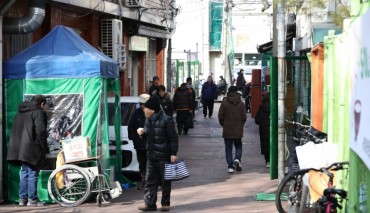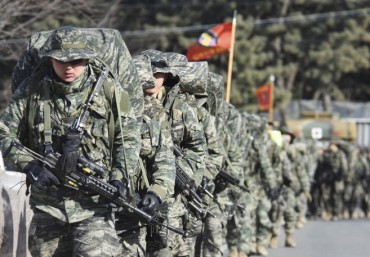
People walk on a street in the eastern coastal city of Gangneung to enjoy blooming cherry trees on April 9, 2022. (Yonhap)
SEOUL, April 9 (Korea Bizwire) — South Korea’s new coronavirus cases fell below 200,000 on Saturday as the spread of the omicron variant slowed down after peaking last month.
The country reported 185,566 new COVID-19 infections, including 40 cases from overseas, bringing the total caseload to 15,169,189, the Korea Disease Control and Prevention Agency (KDCA) said.
Daily infections have been on the decline in recent weeks after reporting an all-time high of over 620,000 on March 17. Authorities are expected to lower the pandemic’s infectious disease level to reflect the downward trend.
A total of 338 died from COVID-19 on Saturday, raising the death toll to 19,092, with the fatality rate at 0.13 percent. The number of critically ill patients fell by six to 1,099 from a day earlier, the KDCA said.
As of 9 p.m., the country had added 161,010 new virus cases, down 21,133 from the same time the previous day, according to data compiled by city and regional governments.
Daily COVID-19 infections are counted until midnight and announced the following morning.

Outbound passengers check in for their flights at Incheon International Airport, west of Seoul, on April 7, 2022, amid eased social distancing rules. (Yonhap)
The government said it is considering lifting the social distancing rules and allowing people to go mask-free outside if the virus stays in check through the end of next week.
On Monday, South Korea eased social distancing rules nationwide to help reduce the plight of small merchants and business owners hit hard by the pandemic.
The cap on private gatherings has been eased to 10 people from eight, and the business hour curfew on public places, like restaurants and cafes, has been extended by one hour to midnight.
Prime Minister Kim Boo-kyum said Friday the government will finalize its decision on adjusting the infectious disease level soon.
COVID-19 is currently classified as a Class 1 infectious disease, the highest in the four-tier classification that falls under the same category with diseases like the Ebola virus and the Middle East respiratory syndrome, and the government is considering downgrading it by one notch.
Class 1 infectious diseases require high-level isolation, such as negative pressure isolation, and immediate reporting on the outbreak.
A downgrade in the infectious disease level can lead to significant changes in virus responses, such as reducing the quarantine period or even lifting self-isolation measures.
The number of fully vaccinated people stood at 44.51 million, or 86.7 percent of the 52 million population, while 64.1 percent had received booster shots, the KDCA said.
(Yonhap)






